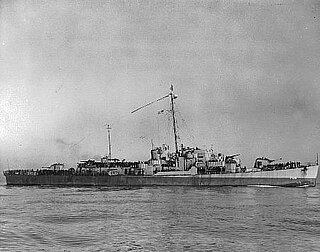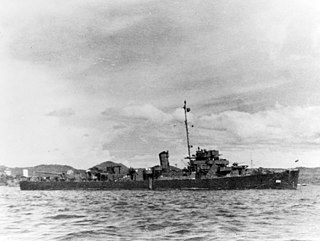
USS Denver (CL-58) was a Cleveland-class light cruiser. Denver launched on 4 April 1942 by New York Shipbuilding Corp., Camden, New Jersey; sponsored by Miss L. J. Stapleton, daughter of the Mayor of Denver; and commissioned on 15 October 1942, Captain Robert Carney in command. It was the second ship named for the city of Denver, Colorado.

USS Mertz (DD-691) was a Fletcher-class destroyer in the service of the United States Navy from 1943 to 1946. She was scrapped in 1972.

USS Eaton (DD-510) was a Fletcher-class destroyer in the service of the United States Navy from 1942 to 1946. She was recommissioned from 1951 to 1969 and sunk as a target in 1970.

USS Stevens (DD-479) was a Fletcher-class destroyer in service with the United States Navy from 1943 to 1946. She was finally sold for scrap in 1973.

USS Cony (DD/DDE-508), a Fletcher-class destroyer, was a ship of the United States Navy named for Joseph S. Cony (1834–1867), a naval officer during the Civil War.

USS Foote (DD-511), a Fletcher-class destroyer, was the third ship of the United States Navy to be named for Rear Admiral Andrew Hull Foote (1806–1863), who served during the Civil War.

USS Robinson (DD-562), a Fletcher-class destroyer, was the second ship of the United States Navy to be named for Captain Isaiah Robinson, who served in the Continental Navy.

USS Drayton (DD-366) was a Mahan-class destroyer in the United States Navy before and during World War II. She was the second ship named for Captain Percival Drayton, a career naval officer who served during the American Civil War.

USS Smith (DD-378) was a Mahan-class destroyer in the United States Navy before and during World War II. She was named for Lieutenant Joseph B. Smith, USN. Smith was a senior officer aboard USS Congress and killed when CSS Virginia sank her.

USS Holt (DE-706) was a Rudderow-class destroyer escort of the United States Navy. She was named after William Mack Holt.

USS Jobb (DE-707) was a Rudderow-class destroyer escort in service with the United States Navy from 1944 to 1946. She was sold for scrap in 1970.

USS Conner (DD-582) was a Fletcher-class destroyer of the United States Navy, the second Navy ship to be named in honor of Commodore David Conner (1792–1856), who led U.S. Naval forces during the first part of the Mexican–American War.

USS James E. Craig (DE-201) was a Buckley-class destroyer escort in service with the United States Navy from 1943 to 1946. She was sunk as a target in 1969.

USS Newman (DE-205/APD-59) was a Buckley-class destroyer escort in service with the United States Navy from 1943 to 1946. She was scrapped in 1966.

USS Lloyd (DE-209/APD-63), a Buckley-class destroyer escort of the United States Navy, was named in honor of Ensign William R. Lloyd (1916–1942).

USS Chepachet (AO-78), originally named SS Eutaw Springs, and later known as USNS Chepachet (T-AOT-78) until disposition, was a Suamico-class fleet oiler, of the T2-SE-A1 tanker hull type, serving in the United States Navy during World War II. Originally a namesake of the Battle of Eutaw Springs when laid down 1 November 1942, she was renamed for the Chepachet River located in a village of Glocester, Rhode Island bearing the same name.

USS Edwin A. Howard (DE-346) was a John C. Butler-class destroyer escort acquired by the United States Navy during World War II. The primary purpose of the destroyer escort was to escort and protect ships in convoy, in addition to other tasks as assigned, such as patrol or radar picket. Post-war, she returned home with one battle star to her credit.

USS Jesse Rutherford (DE-347) was a John C. Butler-class destroyer escort acquired by the United States Navy during World War II and named in honor of Private Jesse Rutherford Jr., USMC. Her primary purpose was to escort and protect ships in convoys; other tasks assigned included patrol and radar picket. Post-war, she returned home with one battle star to her credit.

USS Key (DE-348) was a John C. Butler-class destroyer escort in service with the United States Navy from 1944 to 1946. She was scrapped in 1972.

USS Chester T. O’Brien (DE-421) was a John C. Butler-class destroyer escort in service with the United States Navy from 1944 to 1946 and from 1951 to 1960. She was scrapped in 1974.




















